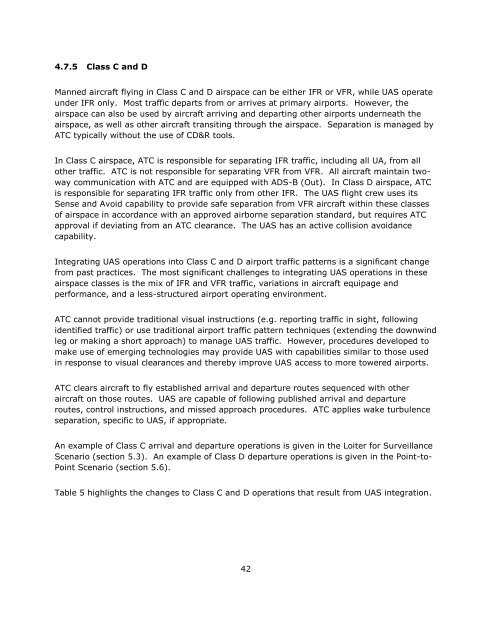FAA-UAS-Conops-Version-2-0-1
FAA-UAS-Conops-Version-2-0-1
FAA-UAS-Conops-Version-2-0-1
You also want an ePaper? Increase the reach of your titles
YUMPU automatically turns print PDFs into web optimized ePapers that Google loves.
4.7.5 Class C and D<br />
Manned aircraft flying in Class C and D airspace can be either IFR or VFR, while <strong>UAS</strong> operate<br />
under IFR only. Most traffic departs from or arrives at primary airports. However, the<br />
airspace can also be used by aircraft arriving and departing other airports underneath the<br />
airspace, as well as other aircraft transiting through the airspace. Separation is managed by<br />
ATC typically without the use of CD&R tools.<br />
In Class C airspace, ATC is responsible for separating IFR traffic, including all UA, from all<br />
other traffic. ATC is not responsible for separating VFR from VFR. All aircraft maintain twoway<br />
communication with ATC and are equipped with ADS-B (Out). In Class D airspace, ATC<br />
is responsible for separating IFR traffic only from other IFR. The <strong>UAS</strong> flight crew uses its<br />
Sense and Avoid capability to provide safe separation from VFR aircraft within these classes<br />
of airspace in accordance with an approved airborne separation standard, but requires ATC<br />
approval if deviating from an ATC clearance. The <strong>UAS</strong> has an active collision avoidance<br />
capability.<br />
Integrating <strong>UAS</strong> operations into Class C and D airport traffic patterns is a significant change<br />
from past practices. The most significant challenges to integrating <strong>UAS</strong> operations in these<br />
airspace classes is the mix of IFR and VFR traffic, variations in aircraft equipage and<br />
performance, and a less-structured airport operating environment.<br />
ATC cannot provide traditional visual instructions (e.g. reporting traffic in sight, following<br />
identified traffic) or use traditional airport traffic pattern techniques (extending the downwind<br />
leg or making a short approach) to manage <strong>UAS</strong> traffic. However, procedures developed to<br />
make use of emerging technologies may provide <strong>UAS</strong> with capabilities similar to those used<br />
in response to visual clearances and thereby improve <strong>UAS</strong> access to more towered airports.<br />
ATC clears aircraft to fly established arrival and departure routes sequenced with other<br />
aircraft on those routes. <strong>UAS</strong> are capable of following published arrival and departure<br />
routes, control instructions, and missed approach procedures. ATC applies wake turbulence<br />
separation, specific to <strong>UAS</strong>, if appropriate.<br />
An example of Class C arrival and departure operations is given in the Loiter for Surveillance<br />
Scenario (section 5.3). An example of Class D departure operations is given in the Point-to-<br />
Point Scenario (section 5.6).<br />
Table 5 highlights the changes to Class C and D operations that result from <strong>UAS</strong> integration.<br />
42


